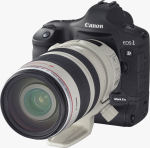 Canon updates the EOS-1D Mark II
Canon updates the EOS-1D Mark II
By
Mike Tomkins
(Monday, August 22, 2005 - 06:00 EDT)
Canon USA has today announced an update to the existing EOS-1D Mark II digital camera, incorporating a wide range of incremental changes based on feedback from professional photographers.
The Canon EOS-1D Mark II N shares an almost-identical body with its predecessor, along with the same 8.2 effective megapixel CMOS image sensor and EF lens mount. The only outwardly obvious change is an increase in the LCD display size; the camera now uses a 2.5" display which Canon tells us has a particularly wide 170-degree viewing angle and a brighter backlight than that found in the original EOS-1D Mark II (pixel resolution of the display remaining identical). Burst depth has increased slightly, to 22 RAW or 48 JPEG frames, and startup time has apparently been reduced from 0.3 to 0.2 seconds. Other changes include the new Picture Style settings found in the EOS 5D model, replacing the Parameters settings from the older EOS-1 series cameras. There are 6 preset picture styles, as follows: - Standard (standard snapshot characteristics, same as Digital Rebel series Parameter 1)
- Portrait (softer and more natural skin tones)
- Landscape (vivid blues and greens, enhanced sharpness)
- Neutral (natural color reproduction with settings that stress image elements, intended for post-processing, same parameters as the EOS-1D series)
- Faithful (color reproduction that colorimetrically matches the original as closely as possible, also intended for post-processing)
- Monochrome (same as on the EOS 20D camera, and the first time this feature has appeared on an EOS-1 class digital SLR)
All of the picture styles can be tweaked to the user's preference, and serve as a starting point for customisation. There are also three user-defined settings, allowing photographers to separately store their own preferred setups. Canon has also taken a look at the camera's dual card slots, and made a number of changes in that area. A new Memory Card Selection button speeds up the procedure of switching between card slots, and a new Split Recording function allows photographers to automatically save RAW files to one card slot while JPEGs are routed to the other, when using the RAW+JPEG mode. It is now possible to low-level format Secure Digital cards in the camera, ensuring that private data can be completely erased from the SD card (note that the CompactFlash slot does not offer this functionality). Folder creation and file numbering is now handled automatically when the EOS-1D Mark II N reaches file number 9999 in a folder, rather than prompting the user whether to create a new folder as in the older EOS-1D Mark II model. It is also possible for users to set the four alphanumeric characters which prefix filenames in the camera, if they wish. There's also a new optional Ec-S focusing screen offering more accurate manual focusing thanks to more pronounced bokeh characteristic at the point of focus when using lenses faster than f/2.8, as well as the ability to set the camera to automatically zoom in on the focus point that was used to lock focus when an image was captured, rather than zooming into the center of the image. Magnified view is also now possible during the camera's quick review function. The camera also now remembers the last image viewed when browsing stored images, and returns to that image when you next resume image playback, rather than going straight to the most recent image - making it easier to browse through a large quantity of stored images while still capturing new images intermittently during browsing. Other changes designed to improve the camera's functionality include ability to adjust ISO while looking in the viewfinder, an enhanced range of settings for burst frames, the ability to access certain menus while images are being processed and recorded, improved PictBridge printing functionality, a new Auto noise reduction function, improved image quality in Magnified view, more complete information display including file sizes, monochrome mode, and R/G/B indicators, as well as more settings for the camera's custom functions. A new locking cap aims to prevent damage to the IEEE 1394 FireWire port, and the Canon logo now uses sunken lettering filled in with white paint. Software included with the camera now includes Canon’s Digital Photo Professional, ZoomBrowser EX, ImageBrowser and EOS Capture. The Canon EOS-1D Mark II N will go on sale in mid-September, with pricing set at US$3999. We've prepared a comparison with all other current cameras in Canon's digital SLR lineup based on these specifications, which can be found in a separate news item, to let readers see how the camera is positioned in Canon's overall lineup. | Canon EOS-1D Mark II N |  | | General | | Camera Type | Pro SLR | | Manufacturer | Canon | | Model Number | Mark II N | | Dimensions | 6.1 x 6.2 x 3.1"
156.0 x 157.6 x 79.9mm | | Weight | 1,225.0 g
42.8 oz | | Planned Price | $3999.00 | | Planned Availability | Sep 2005 | | Image Capture | | Sensor Type | 1.36 Canon CMOS
8.50 megapixels (total)
8.20 megapixels (effective) | | Filter Type | RGBG | | Focal Length Multiplier | 1.30 | | Aspect Ratio | 3:2 | | Image Dimensions | 3504 x 2336 (8.2 megapixels)
3104 x 2072 (6.4 megapixels)
2544 x 1696 (4.3 megapixels)
1728 x 1152 (2.0 megapixels) | | Capture Speed | Continuous: 8.5 frames per second for 48 frames | | Image Preview / Review | | Viewfinder | Yes, Eye-level pentaprism
99% field of view | | LCD | 2.5", 230,000 pixels
100% field of view | | Playback Zoom | 10.0x max | | Lens | | Lens Type | Interchangeable Lens
Varies with lens, thread size unknown | | Aperture Range | Varies with lens | | Focusing System | TTL-AREA-SIR w/ CMOS sensor
Manual Focus possible (0) steps | | Exposure | | ISO Sensitivity | 100 - 1600 in 1/3EV steps,can be extended to 50 - 3200 | | Shutter Speed | 30 - 1/8000 second | | Exposure Modes | Aperture, Shutter, Manual | | Metering Modes | 21-zone evaluative, partial, center spot, AF-linked spot, multi-spot, center-weighted average | | Exposure Compensation | +/- 3.0EV in 1/3EV increments | | White Balance | Auto, daylight, shade, cloudy, tungsten, fluorescent, flash, custom, color temperature, custom, Manual | | Creative | | Self Timer | Yes, 2 or 10 seconds | | Time Lapse | No | | Movie Format | None without audio
Max. frame-rate: 0 frames per second | | Storage | | Recording Medium | CompactFlash Type 1, CompactFlash Type 2, SD/MMC, Microdrive | | File Format | CCD-RAW, 12-bit CCD-RAW, JPEG, WAV | | Connectivity | | Video | Yes, NTSC / PAL switchable | | Computer | USB 1.1, FireWire | | Other | DC In | | Power | | Battery Type | NiMH rechargeable | | Battery Form Factor | Proprietary NP-E3 | | Product Bundle | | Software | Canon Digital Photo Professional, EOS Viewer, EOS Capture | | Flash Memory | 0.0MB | | Other | | Digital Print Order Format (DPOF) compliant | Yes | | Internal Microphone | Yes | | Tripod Mount | Yes, Metal | | Remote Control | Yes, Wired with N3-type terminal | | Operating System Compatibility | Windows, MacOS | | More Photos |  |  |  | 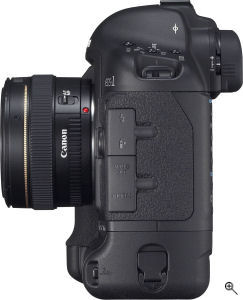 |  | 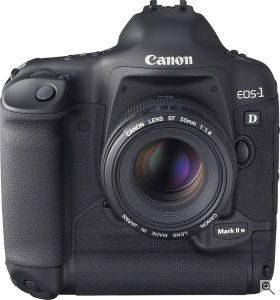 | 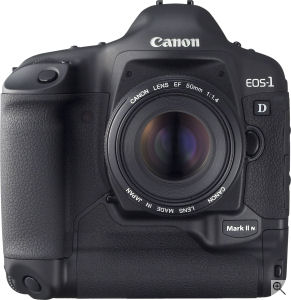 | 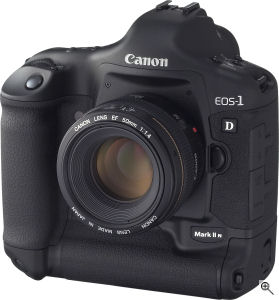 | 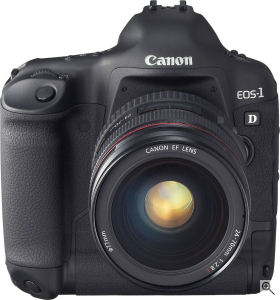 | 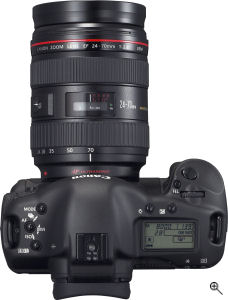 | 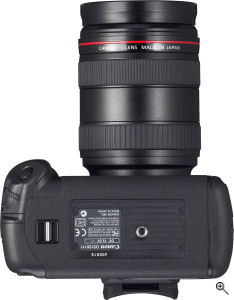 |  |  | 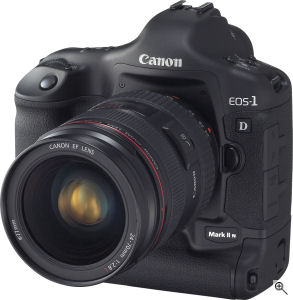 | 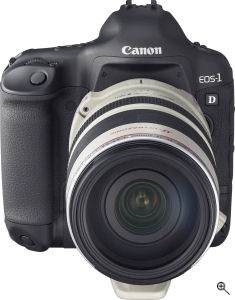 | 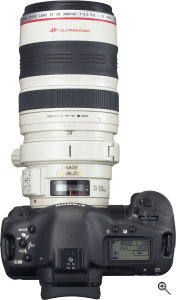 |  | | |
|
Original Source Press Release:
| WITH LARGE LCD SCREEN AND GREATER FRAME BURST CAPABILITY, CANON CREATES NEW PRO STANDARD IN EOS-1D MARK II N DIGITAL SLR The World’s Fastest Digital SLR Just Got Better Thanks to Improved Feature Set With New 8.2 Megapixel Canon EOS-1D Mark II N Model LAKE SUCCESS, N.Y., Aug. 22, 2005 – After successfully creating the world’s fastest digital SLR*, what could Canon possibly do for an encore? Make it even better. And that’s what Canon’s done with the new Canon EOS-1D Mark II N digital SLR, which preserves the speed, responsiveness, image quality and reliability of the popular EOS-1D Mark II model while incorporating newly refined features that make the camera easier and more precise to use. Firing at 8.5 frames per second for up to 48 full-resolution JPEG images in a burst (vs. the same firing rate and a 40 JPEG burst for the 1D Mark II model), the Canon EOS-1D Mark II N camera ups the ante while retaining the superb CMOS Sensor of the 1D Mark II model, with its convenient 1.3x lens conversion factor. Along with its improved burst rate, the 1D Mark II N digital SLR adds a new 2.5-inch, wide-angle view LCD/TFT monitor that offers crisp image playback. Startup time on the new camera has also dropped to 0.2 seconds (from 0.3) with the help of Canon’s DIGIC II Image Processor. The EOS-1D Mark II N camera shares with the EOS-1 series family its all-metal body and chassis and weather-resistant construction with its shutter durability-tested to 200,000 exposures. And perhaps best of all, the price of the new camera, $3,999**, is actually $500 less than the initial price of its predecessor. “Working photographers will feel at home immediately with the EOS-1D Mark II N digital SLR. It has the feel and responsiveness they have come to know and rely on combined with a new ease of use they will appreciate and enjoy,” said Yukiaki Hashimoto, senior vice president and general manager of the consumer imaging group at Canon U.S.A., Inc., a subsidiary of Canon Inc. “With the new EOS-1D Mark II N, we’ve created a new professional standard with enough speed, resolution and features to appeal to a wide range of pros.” Improved Image Playback for Better Views
To give photographers a more accurate view of the pictures they’ve shot, the EOS-1D Mark II N model has a beautiful new, 2.5-inch LCD/TFT monitor with 230,000 pixels of resolution for accurate image playback. Its total viewing area is actually more than 50 percent larger than a 2-inch screen and its backlight is brighter with six LED modules. Thanks to the new screen, examining images in playback, checking focus and selecting menu items are now all easier. The improved display enables viewing angles up to a remarkable 170 degrees from any direction. Sharing the stage with the new, 2.5-inch LCD wide-angle view display are several significant improvements in image playback. For starters, the user can have a magnified view from any selected AF point. Previously, magnified views took the center of the image as the starting point, but a new menu item enables the user to select a specific AF point and magnify the image in 15 steps with the press of a button. Another new feature on the camera is magnified view during Quick Review. When an image is displayed on the LCD monitor immediately after capture, the user can immediately magnify the view to check focus right away. Other improved playback functions include a last displayed image remembered feature and a more complete INFO display which now shows file size and includes notations for monochrome (B/W) and color (R/G/B) when the RGB histogram is enabled. Bigger Bursts and Automatic New Folder Creation So Photographers Won’t Miss a Shot
Photographers always want as many continuous frames as possible. For many pro shooters, even one more shot could prevent that lost photo opportunity. An improved image processing sequence and a better memory management method in the EOS-1D Mark II N digital SLR has ramped up its burst capability with the camera now able to shoot up to 22 RAW frames and up to 48 full-resolution JPEGs in burst. The camera can also shoot 19 frames of RAW+JPEG (JPEG quality: 8, Picture Style: Standard, ISO 100); and at 59 frames or better at the JPEG Middle 1 setting, 77 frames or better at JPEG Middle 2, and 135 or better at JPEG small, a substantial increase. Professional photographers will love the extra margin of comfort that greater burst performance provides. Additionally, the EOS-1D Mark II N digital SLR now creates new folders automatically when file numbers reach 9999, making the new camera more responsive in fast-moving news and sports photography situations. Photographers can even customize the first four characters in filenames, enabling superior image organization and camera identification capabilities. New Split Recording for RAW+JPEG
Just like on the EOS-1D Mark II model, the EOS-1D Mark II N digital SLR lets the user save the same image simultaneously in both the CompactFlash (CF) and SD memory card slots, a highly effective backup mechanism. Photographers can also record to slot one until it was full and then go to slot two as a reserve. Now, with the EOS-1D Mark II N in RAW+JPEG mode, it’s also possible to save the RAW and JPEG images separately in each memory card. The RAW images can be saved in slot one and the JPEGs, in any of ten quality levels, in slot two, or vice versa. Since CF cards tend to be larger, currently, than SD cards, the RAW files will be likelier to go on the CF card in slot one, but this is not required. The new option allows images to be recorded separately according to usage, finally realizing a great potential benefit of the dual slot configuration. Picture Styles for Better Pictures
In the analog era, photographers would select the brand of film that suited their own shooting style or the subject being photographed. In the digital era, they have to rely on the image quality features and settings provided by the camera manufacturer. Some users though have experienced confusion about what effects these settings would have on the image. To provide better clarification, a new feature called Picture Styles combines processing parameters and color matrix settings into easy settings designed to obtain the desired effect, almost like choosing a type of film to obtain a specific result. For users who do not want to bother with post processing, there is a ‘Standard’ setting within the Picture Styles mode that helps to produce images that look crisp and vivid with the sharpness set to mid-scale and the color tone and saturation set to obtain vivid colors. In the ‘Portrait’ setting of the Picture Styles mode, the color tone and saturation are set to obtain nice skin tones with the sharpness set one step weaker than the Standard setting so the skin and hair look softer. Under the ‘Landscape’ setting of the Picture Styles, the color tone and saturation are set to obtain deep blues and greens, the sharpness is set one step stronger than Standard so the outline of mountains, trees and buildings look more crisp. The Neutral setting is the same as the default setting for EOS-1 series cameras where natural color reproduction is obtained and no sharpness is applied. This is the ideal setting for post-processing. The Faithful setting is the same as Digital Photo Professional’s Faithful, so when the subject is photographed under a color temperature of 5200K, the color is adjusted colorimetrically to match the subject’s color with no sharpness applied. Monochrome is the same as the EOS 20D camera’s monochrome setting and with User Defined, the user can create and save their own preferred settings. About Canon U.S.A., Inc.
Canon U.S.A., Inc. delivers consumer, business-to-business, and industrial imaging solutions. The Company is listed as one of Fortune's Most Admired Companies in America and is rated #35 on the BusinessWeek list of "Top 100 Brands." Its parent company Canon Inc. (NYSE:CAJ) is a top patent holder of technology, ranking third overall in the U.S. in 2004, with global revenues of $33.3 billion. For more information, visit www.usa.canon.com.
# # # Specifications subject to change without notice.
All referenced product names, and other marks, are trademarks of their respective owners.
* As of August 22, 2005
** Pricing subject to change at any time. Actual prices are determined by individual dealers and may vary. |
Powered by Coranto
|